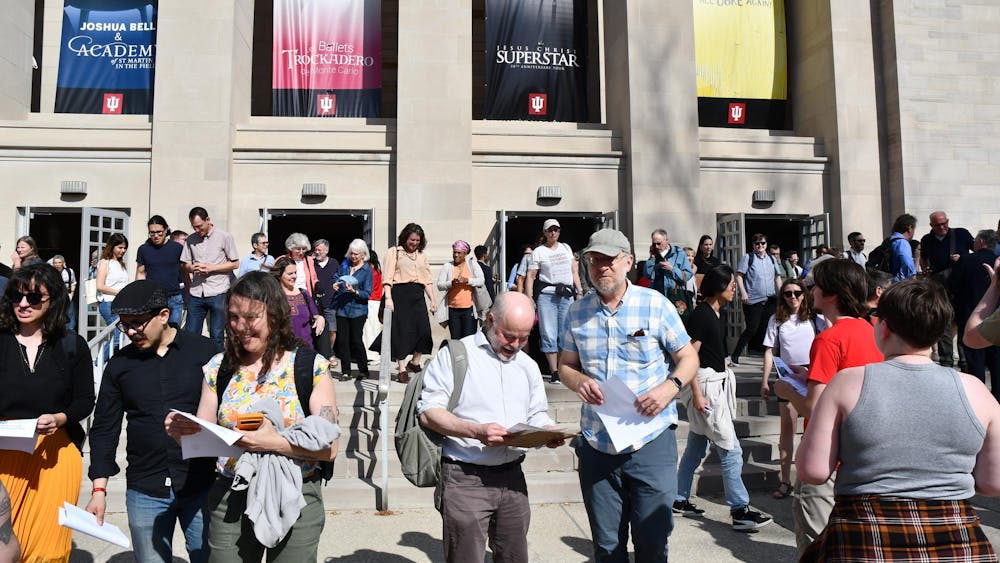Music can have an unexplainable effect on the emotions and actions of individuals, but Rob Potter, associate professor and director of the Institute for Communication Research at the Media School, said he wants to better understand these effects.
The ICR is conducting a research project to determine the psychophysiological effects of music on people. It is intended to determine whether or not there is a difference in an individual’s mental and physical responses to music that is meaningful to them and music that is not.
“Blink for me, Josh,” Potter said. “Frown for me.”
Potter asks the subject to carry out these movements to ensure the kinks in the experiment are worked out. Josh Sites, a graduate student working toward his Ph.D, is a test participant in the experiment.
Although he works in the ICR and has some inclination of what the experiment is about, Sites doesn’t know the overall hypothesis, which he said is ideal.
Potter originally became interested in researching the mental and physical effects music has on people when his friend conducted similar research with the psychological and brain sciences department. Potter said he wanted his research to be different.
“Music affects people’s decision making at times,” Potter said, “I wanted to research whether or not there’s something special with music emotionally.”
Potter began his research when he applied to participate in the center of excellence for women in technology’s research program, which gives him the opportunity to mentor women studying technology.
Each year CEWiT offers Research Experience for Undergraduate Women, or REUW, which consists of various projects that allow undergraduate women to work with a faculty mentor and gain hands-on experience in computing and technology.
Through this program, Potter selected sophomore Claire Dudek to work with him on his research. Potter said he selected Dudek because her passion for music stood out from the other participants who primarily said they thought the experiment sounded interesting.
“Music is always something that’s been important to me,” sophomore Claire Dudek said. “Not so much playing music, but more so listening to it and aligning it with particular moods and situations.”
Although Dudek is not studying a technological field like many students involved in the CEWiT REU-W program, she said she thought it would be interesting because she is a neuroscience major.
“This study was particularly interesting because of the psychophysiological aspect,” Dudek said. “It gave me an opportunity to use equipment that would typically be used in a psychology or neuroscience lab but in a music-based setting.”
After participants for the study have been recruited, the researchers will ask participants to provide them with fourteen songs that are meaningful to them. From the provided fourteen songs, Dudek and Potter will randomly choose ten songs which they will play for them, along with 10 more songs the subjects did not choose.
When participants come into the lab, they will be hooked up to electro nodes, which they refer to as sensors so as to not scare the subjects. These will measure their sweat, heart rate, and the electrical charge of their corrugator supercilii muscle and orbicularis oculi muscle.
Two electrodes are placed on the palm of the subjects non-dominant hand, one is placed on both of the subject’s forearms just below the crease in their arm, and one is placed slightly above the subject’s non-dominant wrist.
“It’s for measuring the amount of sweat on the wrist,” Potter said. “It’s an indication of his sympathetic nervous system, or how excited he is.”
More electro nodes are then placed around the subject’s eyes. These measure the corrugator muscle and the orbicularis oculi muscle.
Because these muscles don’t provide the researchers with as strong of a signal as the heart does, they use alcohol swabs with a small amount of pumice to exfoliate the area and remove things, such as dead skin cells, that could interfere with the connection.
Finally, a gel is applied to the eye area to help conduct electricity from the subject’s neurons to the electro nodes, and the participants are ready to listen to the fifteen-second clips of ten of their favorite songs mixed with fifteen seconds of ten randomly selected songs.
Potter said he is withholding the hypothesis of his research to maintain the integrity of the experiment. He will begin recruiting subjects for the experiment within the next couple of weeks as soon as the kinks are worked out and the data is recordable.






